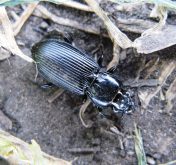CO-OPERATOR CONTRIBUTOR / LETHBRIDGE
You may never have seen it, it doesn t have a common name, it didn t cost you a cent, but it may be saving you thousands in lost yield and pesticide cost.
Tetrastichus julis (T. julis) is a tiny wasp that feeds on the cereal leaf beetle, a Eurasian pest first found in North America in Michigan in the late 1960s, and which can reduce cereal yields to 20 to 50 per cent.
The beetle and its larvae feed on all cereals and many grass species. The larvae, which look like little slugs because they cover themselves in frass (insect waste and mucus), do most of the damage. They feed on the softer green parts of the leaf, leaving windows along the leaf.
Read Also

CUSMA access key among other trade noise: Seeds Canada panel
Seeds Canada conference panelists say Canada needs to stay focused and wait as U.S. trade and tariff chaos develops, and a Canada-U.S.-Mexico Agreement review looms
Adults, shiny black beetles four to seven mm long, with reddish thorax and legs, eat right through the leaf. Both adult and larval cereal leaf beetles feed mainly on the flag leaf where they lay their eggs, and leave the crop looking as if it s been frost damaged.
When it first arrived in North America the beetle devastated cereal crops. Farmers sprayed insecticide to minimize losses, but the insect spread quickly, dispersing across the western U.S. and into Ontario.
The Americans launched a biocontrol program soon after they first found the beetle, searching for some natural way to control the beetle. They found Tetrastichus julis. After its eggs hatch, the wasp larvae feed on and eventually kill the beetle larva.
It s probably the most successful insect pest biocontrol program ever developed, says University of Alberta entomologist, Lloyd Dosdall. It is totally specific, it only attacks cereal leaf beetle. And, as the beetle expands its range, its parasitoid generally follows it within a few years and suppresses the beetle numbers so it doesn t damage yields, he said.
T. julis is a parasitoid, which means it kills its host, rather than a parasite, which lives on but does not destroy it.
Most parasitic wasp species only lay one egg in a host insect. This little wasp is gregarious it lays several eggs in a larva for eight to 10 offspring in each beetle larva it attacks. It can build up large numbers very quickly.
Rapid spread
The cereal leaf beetle was first found in Alberta in the Lethbridge and Taber areas in 2005, and within a few years, most of the beetle larvae in those areas were parasitized with T. julis. Dosdall and Agriculture Canada researcher Dr. Hector Carcamo developed a beetle-parasitoid nursery to study the insects.
They expect the cereal leaf beetle to spread throughout Western Canada s grain-growing areas but they aim to make sure the beetle doesn t go anywhere without its parasitoid.
Dosdall and Carcamo along with doctoral student Swaroop Kher have been monitoring numbers of cereal leaf beetle and its parasitic wasp, especially along our southern border where the insects might invade from Montana. Mostly the two species are dispersing together, but the team has dealt with a couple of isolated outbreaks.
In 2009, there was a huge infestation of cereal leaf beetle in the Swan River Valley in northwestern Manitoba, says Dosdall. That s too remote from southern Alberta for the insect to have reached there on its own. It must have been human assisted, most likely in hay.
Dosdall s team found no sign of parasitization in the beetles from Manitoba, so they sent parasitized beetle larvae to be released there during 2009 and 2010. This year, all the beetle larvae they received from that area were parasitized.
This year, the beetles showed up without the parasitoid in a small area near Edmonton. Once again the team released parasitized larvae. Next year they ll look to see how many beetle larvae are parasitized and likely release more parasitized larvae.
We ve put out a few fires like the
Swan River outbreak, but mostly that tiny wasp has kept up with the beetles and prevented them from doing any real damage. We can t eradicate the beetle, but little T. julis is suppressing it very effectively, he said.
The alternative to the wasp biocontrol is both costly and comes with significant consequences.
I don t know how much money this little wasp is saving farmers, but spraying for it, even on a small part of Alberta s six million acres of wheat, would be a lot of spraying
and loss of many beneficial insects. It s a real success story, for farmers and for investment in research, says Dosdall.
———
In 2009, there was a huge infestation of cereal leaf beetle in the Swan River Valley in northwestern Manitoba.
LLOYD DOSDALL University of Alberta


















